
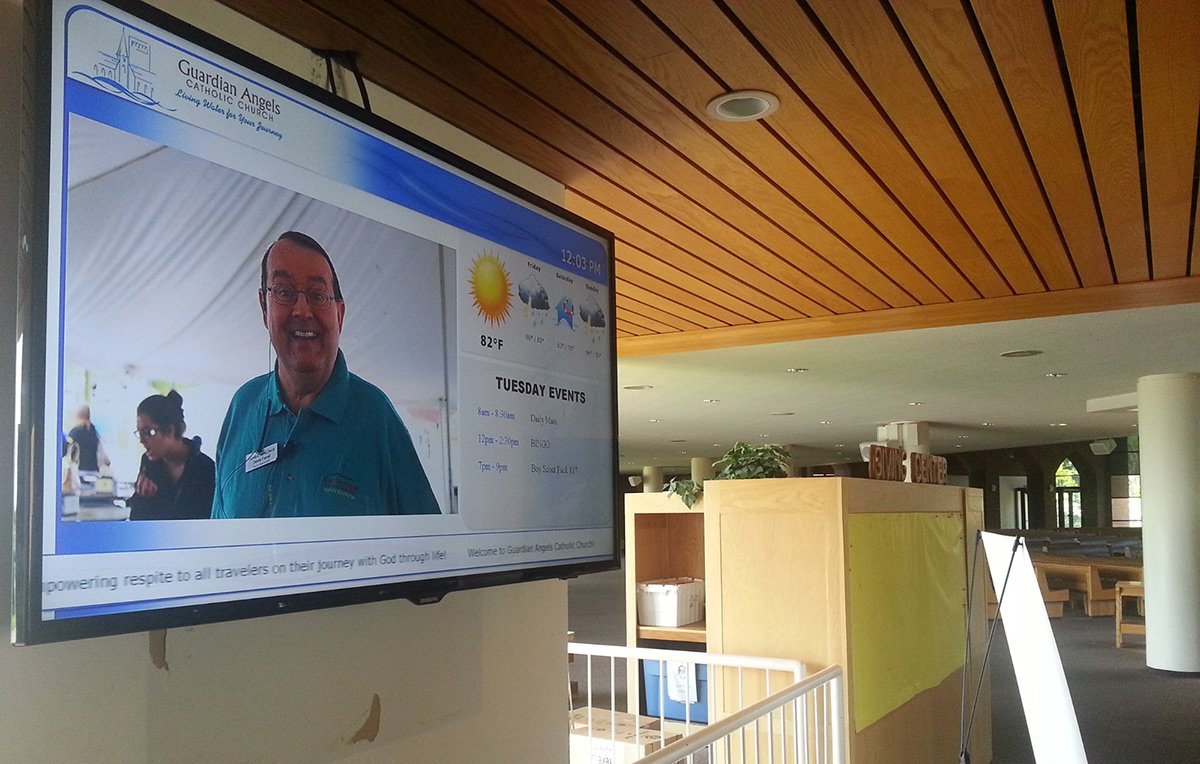
Digital signage lets you show a wide range of content, across multiple displays and locations. In this guide we’ll talk about what it is, how it works, how to use it, and what you can do with it. Let’s start at the beginning: what is digital signage exactly?
What Is Digital Signage?
Digital signage is signage that’s digitally controlled. It usually means flatscreen displays, managed by an application, showing digital content.
How Effective Is Digital Signage?
It delivers several crucial advantages over traditional, static signage:
- Digital signage captures 400% more views than traditional signage (Source)
- 83% of study participants recalled a digital sign they had seen; 47% recalled three; 20% had had a conversation about one (Source)
- 80% of brands that use digital signage experience a rise in sales, of up to 33% (Source)
- Digital signage can incorporate social proofs and peer-to-peer recommendations — the most trusted source for 92% of consumers. (Source)
- 84% of shoppers surveyed said they found digital signage in-store made waiting times feel shorter. (Source)
- In the same survey, 40% said they would be more likely to shop in a store with digital signage near the checkout line.
- Digital menu boards in eateries are associated with a 5% sales lift (Source)
Beyond the kinds of stats you can tweet (go ahead, don’t let us stop you!) there are less-quantifiable, but still-real, benefits to digital signage. At Rise Vision, we specialize in helping education and finance organizations get the best from our digital signage solution. Customers feed back to us that the ability to push new data to every screen in their organization, to address users while they’re waiting or moving from one area to another, and to push dynamic, contextual content updates are all important to them.
The Elements of Digital Signage
Digital signage consists of:
Content
The actual material you display on the signs. This can be text, graphics, animation, audio, video, embedded social media, or combinations. Digital signage lets you display the full range of digital media however you want.
Hardware
The tech you use to make it happen. Includes:
- Displays, from retail-level flatscreen TVs to purpose-built displays with additional functionality like touchscreens or exceptional clarity and durability. (More about digital signage displays)
- Media players, which are sometimes bundled with displays but are available separately too. These usually connect with displays via HDMI and have their own power supply and internet connection. (More about digital signage media players)
- Peripherals, like mounts, wiring, cameras, and so on, as well as external speaker systems
Software
Used to create, schedule, manage and deploy content. Increasingly this is cloud-based, allowing you to access and manage your digital signage dashboard from any device with an internet connection. (More about digital signage software)
Done well, it’s more than a faster, slicker analog for physical signage: it’s a centrally-controlled network of signs that can show animated content, and change what it shows to match locations, events and audiences. It’s not about recreating a billboard on a screen. The screens might be what you see, but it’s the centralization and adaptability that give digital signage its game-changing power.
How Does Digital Signage Work?
Let’s start at the center, with the software used to manage and create content. Sometimes this is more than one piece of software, so some organizations create signage in a tool like Photoshop and display it using a digital signage solution. The best option is a comprehensive digital signage software tool that lets you build up your own content fast from templates, customize it endlessly, and decide which displays to show it on and when. (Rise Vision lets you do all that and more.)
When your digital signage software has new content, it sends that content through the internet to your media player. Sometimes this is physically part of your display, but more usually it’s separate. For Rise Vision users, powerful, low-cost players with Rise Vision already installed are available. Your content arrives at the player and is translated into terms the display can understand, then transmitted to the display, usually via a USB or other direct connection.
Digital signage isn’t so much broad as it is versatile. You really can use it for a ton of different things.
What Is Digital Signage Used For?
Digital signage is used wherever content needs to be changed regularly or frequently, or whenever an organization needs to have its staff or service users pay attention. Its first use cases were in situations where traditional static signage imposed time-consuming workarounds. Most of us saw our first digital signage in an airport or a train station, where there’s a lot of information to display and it changes often. Physical signage was never equal to the task.
However, digital signage quickly moved into other areas. Now you’ll find it in nearly every business or organization you visit. It’s almost completely replaced static signage.
Digital Signage Locations
You’ll find digital signage in places like:
- Public spaces such as parks or main thoroughfares
- Corporate headquarters, meeting rooms, and offices
- Sales departments
- Tourist information centers
- Retail stores
- Restaurants
- Museums
- Schools and universities
- Exhibitions and trade shows
- Conferences
Digital Signage Uses
Digital signage is used for:
- Wayfinding, including on school campuses and at venues
- Events advertisement and management
- Menus and options, including purchases, information and more
- Culture and values, including inculcating positive attitudes at school and work
- Scheduling, including transportation, events, and programming/content
- News and information
- Recognition, praise and engagement
For example, a school might use its digital signage for menu boards in the cafeteria, to encourage positive behaviors in the hallways, and to help students (and staff) find their way around campus. The same school might seek to praise student achievement, recognize staff, and present different news reports on different displays around the school; manage queueing and sign-in at reception; and advertise upcoming events like sports or performing arts.
Types of Digital Signage
Interactive Digital Signage
In stores, digital signage can capture users’ attention in ways that traditional signage can’t. Obviously, traditional static signage can’t provide meaningful interactivity. But digital signage can offer experiences similar to those we’ve come to expect online. Users can interact with branded signage that looks, feels and functions like the company website; directions, shopping options, quizzes and find-your-fit services can all be delivered direct from signage. Interactive digital signage can even facilitate purchases directly; look around your local fast-food places and see if you can spot the self-ordering kiosks that are cutting wait times and driving up profits.
Outside retail, there are numerous other roles for interactive digital signage. Schools catering to young children can incorporate signage into games and lessons; at the opposite end of their educational careers, students can get value from interactive job boards like this one, at the University of South Alabama Mitchell College of Business:
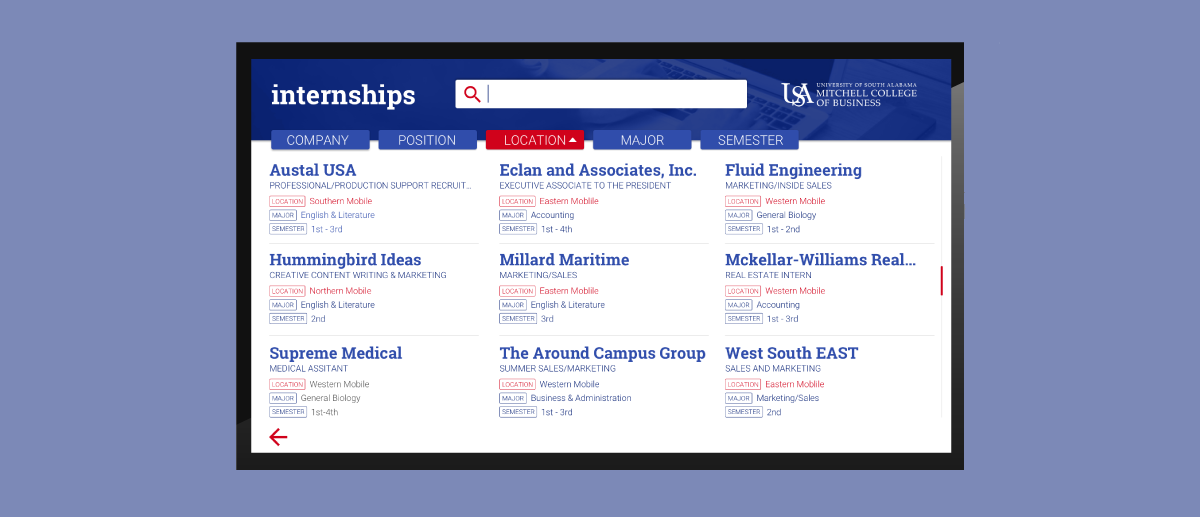
Dynamic Digital Signage
Dynamic digital signage is shown on displays according to a schedule. It usually visually changes every few seconds, like a slideshow or a series of short videos. Its big advantage is that it lets you put a lot of content in front of the same people, so it’s common to see it used where a need for information meets a captive audience. Next time you’re in the doctor’s office or the airport, the screens you can see will probably be showing dynamic digital signage. It’s also commonly used for healthcare displays and for advertising in retail environments.
Because it works best on people who are exposed to it for a while, it’s less often used in on-street advertising, but there is an exception: a development of the idea of dynamic signage that uses facial recognition and other tools to detect the age, gender and other characteristics of the audience, then tailors the content it shows to the relevant segment.
This makes the content seem personalized, and as gesture recognition becomes more common too, the tendency to blur the line between dynamic and interactive signage will grow stronger.
Automated Digital Signage
Automated signage is most familiar from real estate agents’ windows, where it’s been used to display properties for over a decade. However, it’s becoming more commonly used in public transport displays and other situations where content can be pushed in real time from a central control system, rather than being scheduled or repeatedly showing the same content. It’s also increasingly prevalent in factories and even offices to display situationally-relevant safety and production messaging, show key performance indicators, and display quality metrics.
Using Mobile and Digital Signage Together
Mobile signage can work to further stitch together digital and physical experiences. Digital signs can incorporate calls to action on mobile. The simplest way is to encourage users to engage with a hashtag on Twitter or Instagram — by answering a question, posting a photograph, or getting involved in some other way. This has the advantage of making it easier to track the efficacy of your campaigns, at least at the top of the funnel, simply by watching the hashtag’s popularity.
QR codes can also be used to link signage and mobile in innovative ways. Use them directly on signage to encourage users to download maps, apps, email coupons and calendar event invites and reminders.
Digital signage can be used as part of a proximity marketing or communication solution, either through visual codes displayed in signage or by combining signage with tagging (in badges or other wearables) or Bluetooth beacons and a smartphone app.
Digital Signage and Live Events
Live streams from events are a key feature of the online world. You can watch the news as it happens, see footage from NASA probes or catch highlights from sports events worldwide, as well as dip into the work of millions of content creators who know the value of a live event in bringing eyeballs and attention to their product.
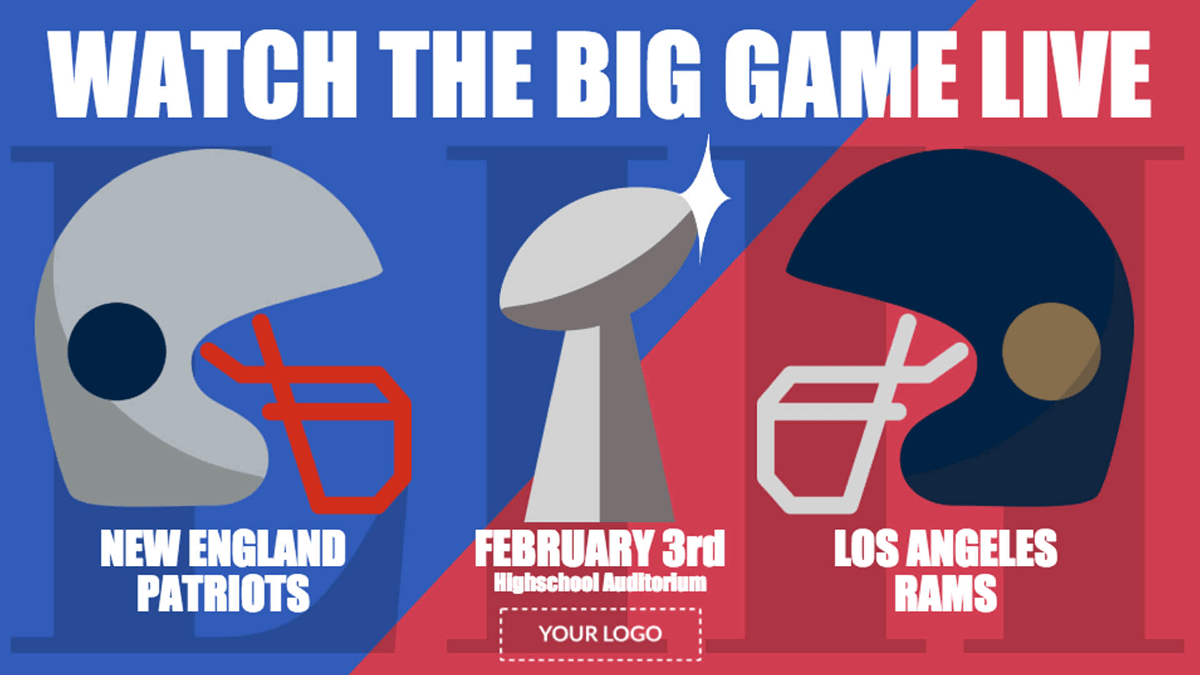
There’s a ton of live streaming content out there that likely is appropriate for your audience and goals. Educational institutions can stream distant sports matches and other competitive events to the home crowd; businesses can show relevant conferences and talks, especially where staff are involved.
What’s crucial about live events as a part of the digital signage equation is that they bring immediacy, providing real value to viewers and pulling eyeballs.
Digital Signage for Businesses
Businesses can utilize digital signage inside and outside the organization. Externally its functions are clear — analogous to traditional signage but far more effective. Customer- and prospect-facing digital signage increases awareness and engagement, translating to greater numbers of repeat customers and thus impacting the bottom line.
Internally, digital signage can be used to alert staff to messages or developments that the entire organization needs to know about, serving as a rapid communication conduit when public announcements must be made as well as displaying reminders of desirable actions. Internal digital signage networks allow businesses to communicate faster and more effectively, and businesses know this: it’s why 56% of internal communications teams are planning to adopt or increase their use of digital signage.
Digital Signage for Schools and Educational Institutions
In schools, digital signage can serve similar functions to internal business use cases, acting as a communication channel for important messaging. At different times throughout the school day and year, it can also be used for guiding staff, students, visitors and parents through events or to specific locations as well as for reinforcing positive messaging.
National Presbyterian School in Washington DC has implemented digital signage throughout the school, using it as a tool to display campus updates, lunch menus, maps and school calendars as well as to display photos.
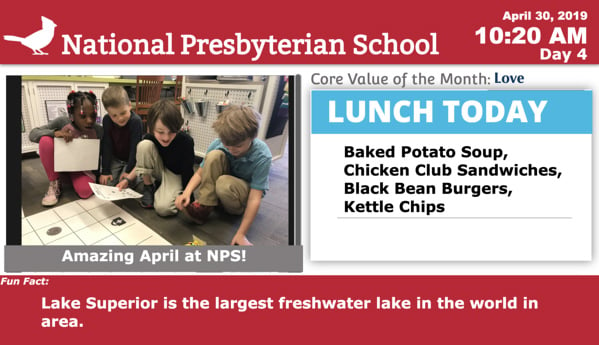
Using Rise Vision and photo CMS Vidigami together lets National Presbyterian’s two-person digital signage team — each of whom has many other roles — create slideshows that showcase the best of their school and reinforce their values, as well as letting students know what’s for lunch.
Digital signage use is already extensive in education: 70% of colleges, and 87% of K-12 schools, have already installed digital signage. It’s also expanding rapidly, as administrators, staff and students alike see the benefits: in 2019, 73% of educational institutions said they saw digital signage as essential to the future of campus communications.
Digital Signage for Healthcare
Healthcare providers can benefit from digital signage by using it as a tool for communication in a similar way to schools, as well as to encourage donations from visitors and patrons. Lobby signage can act to engage visitors as well as to direct them and to help them deal with the discomfort of waiting for appointments, while digital directories and maps help people find their way around the facility and get the help they need.
How Do You Create Digital Signage?
In back of traditional billboards, it’s wood and glue. In back of digital signage, it’s a little like a website’s backend, and a little like a desktop publishing tool. If you’ve ever used a tool like WordPress or built a presentation in Microsoft PowerPoint, the interface of most digital signage tools will be reasonably familiar.
Ours looks like this:

You can’t see it on the larger picture, but there’s a menu bar up at the top there that looks like this:

Using that, you can manage your whole Rise Vision account and all your presentations from a single dashboard, so you’re always in control.
You can configure graphics, videos, text, and set timing, insert interactive content, live streams or video hosted elsewhere. It’s browser-based, and the result can be thought of as a website that’s shown from a lot of monitors at once.

Rise Vision uses templates to get users started quickly and deliver the value of what we do without having to get too into the weeds on detail, but nearly everything about what shows up on those monitors can be changed. If you want to you can build your signage content from scratch yourself.
There are templates for events:

Get started with this Halloween party digital signage template here.
...for announcements…
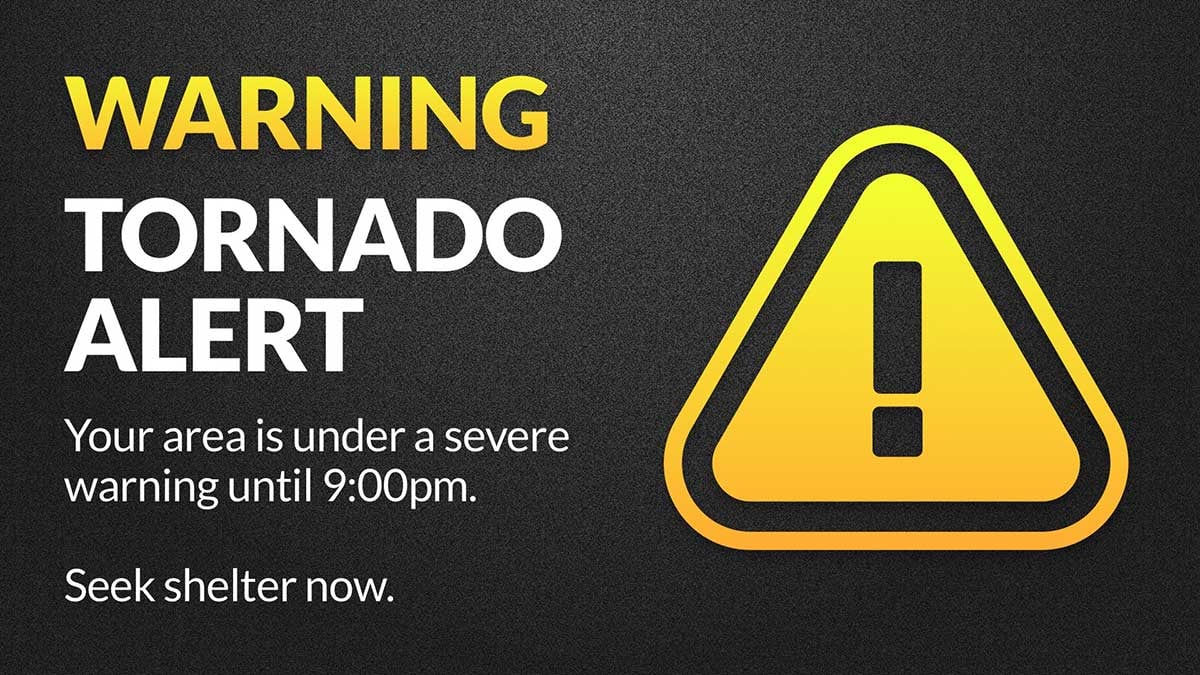
Get started with this CAP alert digital signage template here.
...and for financial literacy education, among many others.

Get started with this financial literacy digital signage template here.
Rise Vision signage content is built in three stages. First, you’ll create your presentation — whether direct from a template, from scratch, or by adapting a template to suit your needs.
Next, you’ll add a display. This is an infrastructure step; you’ll only have to add each display once. Once it’s in the system, you can then add it to schedules to have content shown on it.
This brings us to schedules. Schedules are how you decide which content will be shown on which displays and when. You can create variations on the same display and show them in different locations, or show completely different content depending on where the displays are located. For instance in schools, it’s common to want to show different content in corridors, the lobby, and the cafeteria. It’s also common for schools to have an audience of school students during the day and extracurricular or adult class attendees after school hours; scheduling can let you address both groups of audiences, easily and centrally.
Once you’ve selected a player, built presentations and scheduled them, you’re good to go!
Can I Use PowerPoint for Digital Signage?
You can construct bare-bones digital signage solutions using slideshow tools like Powerpoint or Google Slides, and this is where many organizations start their digital signage journey. However, it’s very limiting: these tools don’t give you a lot of options when it comes to graphics and layout. You’ll often find yourself spending a lot of time creating slides that don’t look very good, then walking the halls with a thumb drive to update displays. Compare that with a tool that lets you create, schedule, and run a whole school’s digital signage in just 15 minutes a week, and the benefits of a real digital signage solution become clear.
Conclusion
Digital signage is already everywhere. It’s increasingly pervasive as more organizations discover its unique benefits. It can be relatively simple to set up a digital signage system that delivers amazing results. And when you choose the right tools, you can deliver the right message to the right audience at the right time in a way no other medium can.





